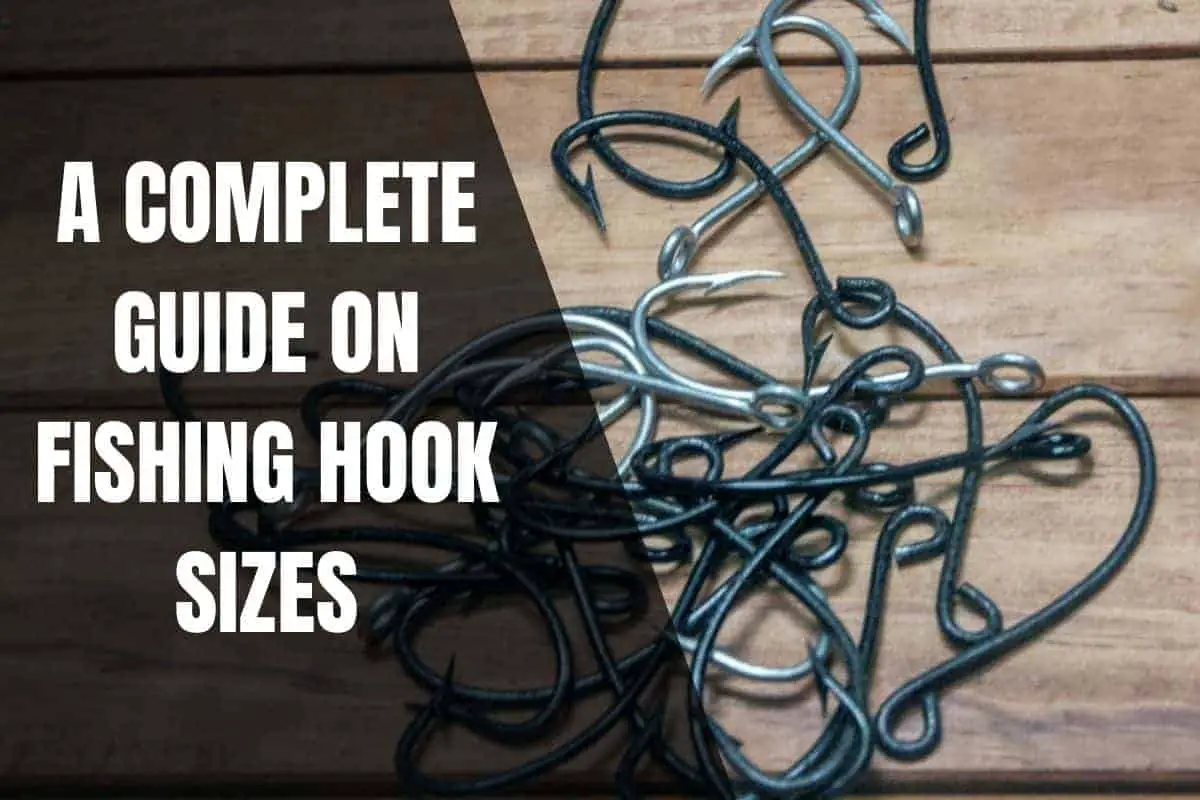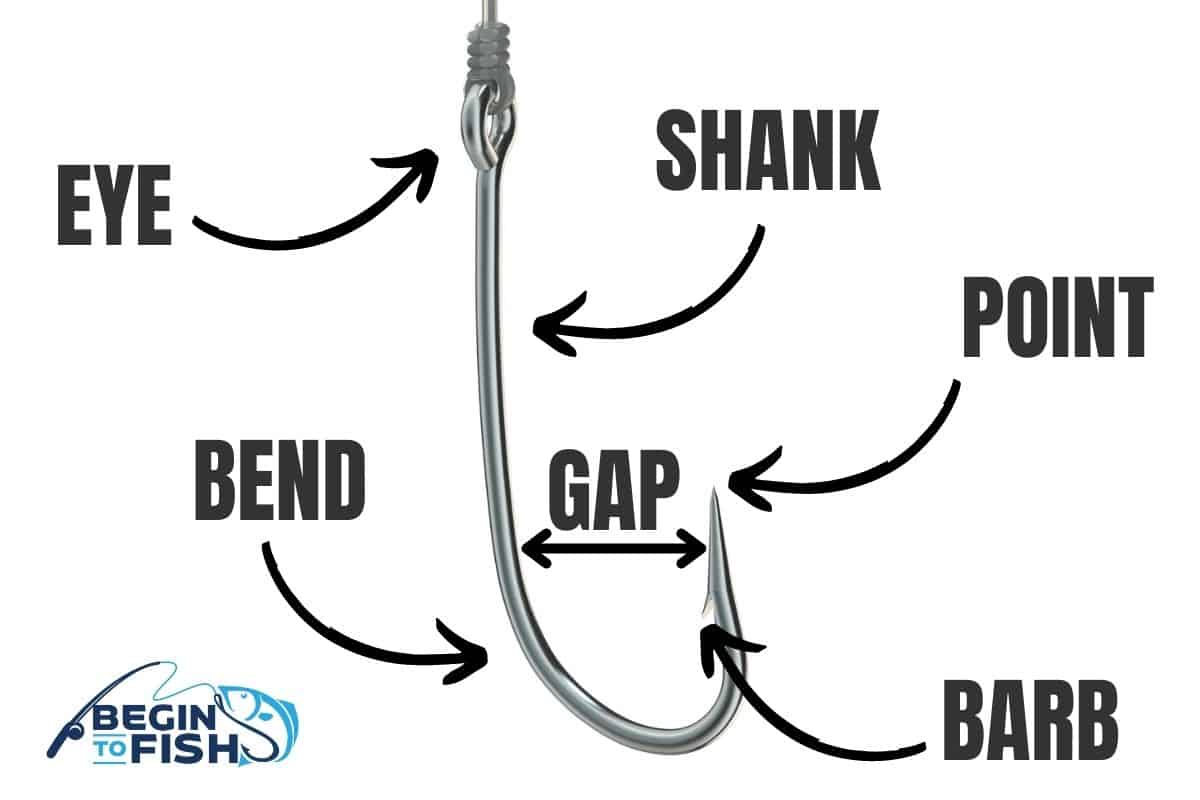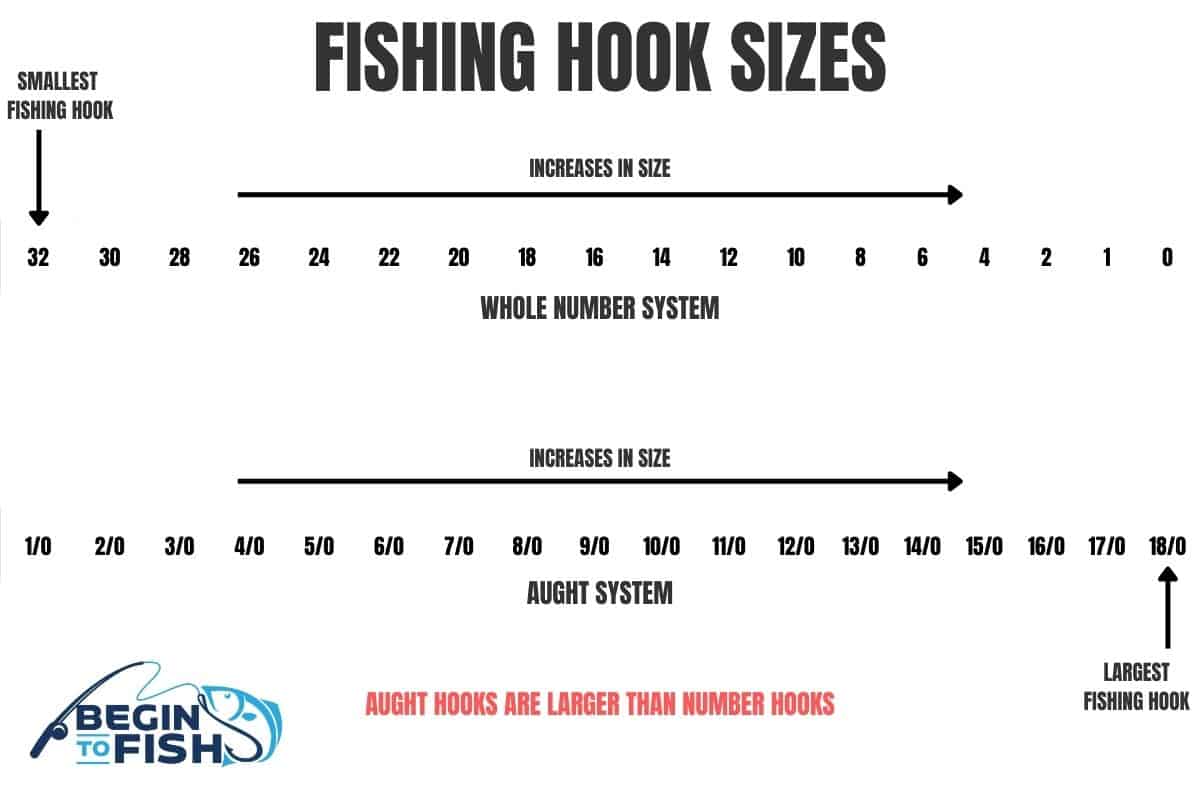Every angler knows that the hook is just one of the many parts of the fishing experience. But not all hooks are the same, and there exist plenty of sizes and variations of fishing hooks. New and even experienced anglers may need fishing hook sizes explained. So let’s look at the sizes and types of fishing hooks and see when the best time to use each is.

Fishing Hook Terminology
Before discussing the various sizes and varieties of fishing hooks, you should get to know the general terminology related to them. Most of the terms are simple but learning them is key to determining the size of the hook.

Eye
The eye is the part of the hook that connects to the fishing line. It is a small circle which anglers feed the line through.
Bend or Curve
The bend or curve is where the hook turns from straight to curved.
Shank
The shank is the longest part of the hook. It runs from the eye to the bend.
Point
The point is the sharp end of the hook. It is sharp enough to pierce a fish’s mouth.
Barb
The barb is found directly below the point. It is a small projection used to keep the hook in the mouth of the fish and not let it escape.
Gap
We call the distance between the shank and the point the gap. You can use this measurement to determine the size of the hook.
Fishing Hook Sizes Explained
Now that you know what we call each component, we can discuss fishing hook sizes. Try not to feel self-conscious about not knowing how fishing hook sizes work, as it can be complicated.
First, it is critical to note that fishing hook sizes are not entirely standardized. This means that while hooks listed as the same size will be relatively similar in size, they are not exactly alike.
A hook made by Eagle Claw listed as size 8 will be slightly different from a hook from Gamakatsu with the same size. Think of it similarly to how clothes from separate manufacturers might fit differently even if they are both listed as the same size.
There are around 37 different sizes of fishing hooks available to purchase. Fishing hooks use two scales, a system using whole numbers and the aught system.

Whole Number System
The whole number system runs from 32 to 0, using mostly even numbers along the way. In this system, 32 is the tiniest variety of hook, while 0 is the largest. This system can be a little confusing for new anglers. To put it simply: the larger the number, the smaller the hook.
Aught System
After 0, fishing hook sizes continue in a different numbering system. Most anglers refer to this as the aught system, and sizes look like 2/0 or 5/0. This system runs from 1/0 to 20/0. Unlike the whole number system, higher numbers indicate larger hooks in the aught system.
What is the Smallest Fishing Hook Size and What is it Used For?
The smallest fishing hook size is a 32 in the whole number system. These hooks are particularly small, and anglers typically only use them for tying flies while fly fishing.
For the average angler, the smallest size hook you will likely need is around size 14.
What is the Biggest Fishing Hook Size and What is it Used For?
The largest fishing hook size is 20/0. This hook is massive compared to the hooks the average angler uses. Anglers only really recommend these hooks for ocean fishing. Experienced anglers use them to catch sharks, swordfish, or giant tuna.
For most applications, the average angler will likely need a hook at around the 2/0 size.
How to Measure Fishing Hook Size
Most fishing hooks purchased from your local bait shop will have the size printed on the packaging. If the packaging is lost, you can get a rough idea of the size of the hook. Measure from the shank to the point to determine the gap, and then compare that size with a chart to estimate the size of the hook.
The measurement is only an estimate, as fishing hook sizes vary between manufacturers. Fishing is not an exact science, and having a general idea of the hook size should be sufficient in determining what fish you can catch with the hook.
What Size Fishing Hook to Use
With so many sizes to choose from, it can feel intimidating for beginners to know what hooks they might need. The good news for most anglers is having only a few sizes will be sufficient. Anglers can determine the size to purchase by where they’re fishing and what they’re fishing for.
Before we look at the different sizes suggested for different fish, it is vital to remember that these are rough guidelines. Fishing hooks are not a one-size-fits-all system, and what might work for one angler in one part of the world might not work for you.
It’s critical to try out different hook sizes at your favorite fishing hole to see what works best. But these general guidelines should give you a good idea of what to buy before heading out.
In my personal experience fishing in local lakes and streams, most freshwater anglers’ average fishing hook size ranges from around 12 to 6.
Freshwater Fish
We’ll begin with trout, one of the most popular fish breeds for freshwater anglers. Anglers can catch trout with hooks ranging in size from 14 to 4. Fly fishers may even use hooks down to size 30 for trout.
With such a large range, it is important to buy a few different sizes to try out in your local waters. After some trial and error, you’re sure to determine the best hook for your local trout.
Bass rival trout in freshwater popularity, but are a fair bit larger. Bass are best caught with hooks ranging from 4 to 6/0.
Catching carp is a rewarding experience, and landing one as a child is one of my favorite experiences while fishing. You can catch a carp with hooks from size 6 to 2/0, depending on the variety and size of the carp.
Catfish are a unique-looking fish and can be a source of pride for any angler landing one. Use larger hooks for catfish, such as ones sized from 2/0 to 8/0.
Walleye can grow to be massive fish, and using the right hook can ensure you catch one. Hooks sized between 4 and 4/0 should be sufficient for landing one of these behemoths.
Pike is another prized freshwater fish that any angler would be happy to land. For pike, try hooks size 1/0 through 6/0.
Bluegill is an attractive fish that anglers can plentifully find throughout the United States. Use a hook between 12 and 6 to catch a bluegill.
Yellow perch can be tricky to catch, but having the right hook can make all the difference. Use a hook between sizes 8 and 2 for them.
Saltwater Fish
Tuna is a popular fish for eating, and the fish itself comes in many shapes and sizes. If you’re fishing for smaller Albacore tuna, try using a size 2 hook. But if your goal is to land larger Bluefin tuna, you might want to try hooks closer to 12/0.
Like tuna, sharks greatly vary in size. For instance, anglers can land a small angel shark with a 1/0 hook. Larger sharks like hammerheads might require the use of hooks up to size 19/0.
Sea bass is distinct from freshwater bass due to their larger size. For sea bass, anglers recommend using a hook from sizes 1/0 to 5/0.
Red snapper is a fish that is as pretty to look at as it is to eat. Anglers on the hunt for these fish should come with 3/0 to 8/0 sized hooks.
Perhaps no fish is as impressive a trophy as the mighty blue marlin. I would recommend a hook between the sizes of 8/0 to 14/0 if you intend to try and land this beautiful fish.
Types of Fishing Hooks
Along with the many different sizes, hooks also come in various forms. These hooks have slightly different shapes that bring different advantages and disadvantages. Let’s look at some of the most popular fishing hooks available today.
J Hooks
J hooks are the most common hook used in fishing, and it’s probably the variation of hook that appears in your head when someone says the word. These can be found at any local bait shop and in all of the sizes mentioned above. They are great for beginners and experienced anglers alike.
Circle Hooks
Circle hooks are the other most common variety. These hooks have exploded in popularity as of late. Circle hooks have a more circular appearance, from which they take their name. They increase the likelihood of hooking a fish while decreasing the chance of “gut hooking” a fish. Gut hooking is the term for a fish that swallowed the entire hook. An angler cannot dislodge the hook without putting the fish in danger.
Circle hooks do not require you to set them in the same manner as other hooks. Instead, the circle hook slides out of the throat, and the barb lodges itself into the fish’s mouth. This may take some time and practice to get right, but you’ll find yourself gut hooking a lot less fish once you do.
Treble Hooks
Treble hooks differ from the rest by having two or three hooks instead of just one. They are typically used in lures and are common in any local bait shop.
Aberdeen Hooks
Aberdeen hooks are thinner than the standard J hook and great for bait fishing. Its thin design ensures the least amount of damage possible to bait, keeping it alive and well and able to attract more fish.
Octopus Hooks
Octopus Hooks are similar to circle hooks with a curved shank, though octopus hooks are not as circular. They are lightweight and perfect for bait fishing.
Egg Hooks
Anglers can use egg hooks when using salmon eggs or other prepared bait. It has a wide gap and a much shorter shank than standard hooks.
O’Shaughnessy Hooks
These hooks are the preferred way to fish with bait in saltwater. They are distinctive with their rounder bend than most hooks.
Offset Shank Hooks
You can identify the offset shank hook by the L-shaped shank. Plastic worms are the typical bait anglers use for them.
Siwash Hooks
Siwash hooks have a straight eye and a long shank. They are perfect for use with lures.
Worm Hooks
Worm hooks look similar to offset shank hooks and work well with plastic bait. They are large and leave plenty of room for the plastic bait.
Weedless Hooks
Weedless hooks have a very distinctive design, with a weed guard coming from the eye of the hook to the point. This guard prevents it from getting tangled up in weeds.
What Are Fishing Hooks Made of?
Companies manufacture most hooks with either iron or steel. Saltwater hooks are rust-resistant, while freshwater hooks typically do not have this quality. A hook in saltwater rusts faster than one in freshwater.
Be careful using a stainless steel hook, as its resistance to rust can be a detriment to the fish in some cases. If a fish has swallowed the hook entirely, you will need to cut the line and leave the hook inside of it. A stainless steel hook is unlikely to rust away, endangering the fish in the long run.
J Hooks or Circle Hooks?
In recent years, a discussion has begun to grow around the decision to use either circle or J hooks. Governments across the United States have enacted laws mandating the use of circle hooks, such as the government of New Jersey for all anglers fishing for striped bass. The government of Maryland has also made similar mandates to protect the striped bass population.
Much ink has been spilled over this debate, but we can look at some of the pros and cons of using each hook variation.
J Hooks
J hooks have long been the standard in fishing and are still the most popular hooks available. They are most commonly used for live bait fishing and require the angler to set the hook when a fish bites. A mistimed set can cause injury to the fish.
Pros of Using J Hooks
- Great for live bait fishing
- The sharp point and barb ensure a hooked fish stays on the line
- Available in almost every size
Cons of Using J Hooks
- You must set the hook yourself, meaning fish can slip away if the maneuver is poorly timed
- Fish can potentially swallow the hook, leading to injury
- The hook will embed itself randomly in the fish’s mouth
Circle Hooks
Circle hooks have quickly grown in popularity, and are a favorite of conservationists. They are less likely to injure a fish.
Pros of Using Circle Hooks
- No setting of the hook is required
- Lower chance of injury to the fish
- Useful for live bait fishing
Cons of Using Circle Hooks
- Less common in bait shops
- The new techniques can take some time to get used to
- Accidentally trying to set the hook will cause you to lose the fish
Frequently Asked Questions
How to choose the right size fishing hook?
Various factors go into this decision, including your local body of water and the species of fish you are attempting to catch. In general, smaller hooks are better for smaller fish and larger hooks for larger fish. If you’re not sure what you should be using, ask a fellow angler what size they are using.
How do fishing hooks work?
A fishing hook uses the point to pierce the mouth of the fish. Most hooks have barbs to prevent the fish from escaping.
Can I use a hook with a barb?
While these hooks are the most common, some local laws prevent the use of barbs. Ensure the legality of a barb before fishing.
Happy Fishing & Tight Lines
